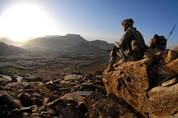Secure the cities first?
Entry Excerpt:
 Taking inspiration from Dave’s “Back Off” post, I was disturbed to read this Huffington Post commentary highlighted at the always readable Abu Muqawama. The assessment comes from a human rights researcher in Kabul asserting the Taliban effectively control Kandahar outside the gates of our bases. It would be presumptuous to rule on the accuracy of the claim, but the assessment (echoed elsewhere) sparks an interesting set of questions about our potential courses of action in Afghanistan.
Taking inspiration from Dave’s “Back Off” post, I was disturbed to read this Huffington Post commentary highlighted at the always readable Abu Muqawama. The assessment comes from a human rights researcher in Kabul asserting the Taliban effectively control Kandahar outside the gates of our bases. It would be presumptuous to rule on the accuracy of the claim, but the assessment (echoed elsewhere) sparks an interesting set of questions about our potential courses of action in Afghanistan.
Noted classical counterinsurgency author and Vietnam War veteran Jack McCuen argued in his excellent book The Art of Counter-Revolutionary War that chasing guerrillas around the countryside while leaving the critical provincial and national population centers uncovered played into the hands of the insurgent. McCuen argued allowing the insurgent to establish networks, shadow governments, recruitment cells, and support networks in the cities created a far greater risk than the loss of rural hamlets. Motivated by McCuen’s book and some other reads, I suggested consideration of a city based approach in a Small Wars Council thread about a year ago. COIN savant David Kilcullen suggested the same strategy in a New Yorker interview not long thereafter. Kilcullen articulated the problem far better than I:
“Meanwhile, the population in major towns and villages is vulnerable because we are off elsewhere chasing the enemy main-force guerrillas, allowing terrorist and insurgent cells based in the populated areas to intimidate people where they live. As an example, eighty per cent of people in the southern half of Afghanistan live in one of two places: Kandahar city, or Lashkar Gah city. If we were to focus on living amongst these people and protecting them, on an intimate basis 24/7, just in those two areas, we would not need markedly more ground troops than we have now (in fact, we could probably do it with current force levels). We could use Afghan National Army and police, with mentors and support from us, as well as Special Forces teams, to secure the other major population centers. That, rather than chasing the enemy, is the key.”
Although some have disputed his eighty percent figure, the question remains – should the bulk of our forces conducting “clear, hold, build” efforts be spread among outposts in the Korengal Valley and Helmand province, or focused on securing the cities while conducting precision raids on the outside?
The disruption of security in the capital and major cities is a major information narrative victory for those who oppose the government. After all, if a government cannot secure its own provincial capitals and government officials, can it reasonably be expected to gain the allegiance and confidence of its citizens? We saw a major confidence setback in the infamous daylight Kandahar prison break last year, which shook the confidence of the entire nation. The Taliban have increasingly mounted multiple suicide attacks in the major cities to undermine confidence in the government. When combined with the rampant corruption alleged in Kandahar, is it any wonder the Taliban are gaining ground?
On the flip side, one can argue that a defensive orientation doesn’t win wars. Such a discussion is beyond this blog post, but I was impressed with the statement from Lieutenant Colonel Chris Cavoli in Chapter 2 of the Accidental Guerrilla that “defensive” COIN operations were the best way of seizing the initiative from the enemy. (p. 96) Would we better off with a “cities first” COIN strategy, or does the rural character of Afghanistan demand our main effort focus in the rural areas? Sound off in the comments or at the Council.
Image credit and background - U.S. Army Sgt. Robert Newman, Bravo Company, 1st Battalion, 4th Infantry Regiment, U.S. Army Europe, watches the sunrise after a dismounted patrol mission near Forward Operating Base Baylough, Zabul, Afghanistan, March 19, 2009. (U.S. Army photo by Staff Sgt. Adam Mancini/Released)
--------
Read the full post and make any comments at the SWJ Blog.
This forum is a feed only and is closed to user comments.





 "A Sherman can give you a very nice... edge."- Oddball,
"A Sherman can give you a very nice... edge."- Oddball, 


 Taking inspiration from Dave’s “
Taking inspiration from Dave’s “


Bookmarks